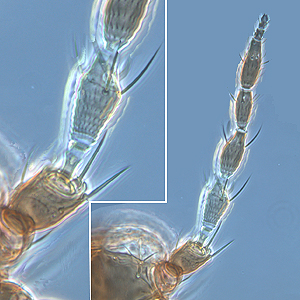Figures
Fig. 1: Antenna (inset: II. and III. antennal segment)
Fig. 2: Head dorsal with ocellar triangle
Fig. 3: Pronotum
Fig. 4: Meso- and metanotum
Fig. 5: Fore- and hindwing
Fig. 6: Sternites V and VI
Fig. 7: Tergites VII and VIII
Fig. 8: Tergites VIII and IX
ITS-RFLP gel patterns (1&8 ladder, 2 PCR-product, 3 RSAI, 4 HaeIII, 5 MspI, 6 HinfI, 7 AluI)
Fig. 09: Primer pair O1/18J
Fig. 10: Primer pair P1/28Z
Fig. 11: Primer pair 18SMP/28SMP
Taxonomic Information
Species:
Frankliniella parvula Hood, 1925
Common name:
Banana flower thrips
Present taxonomic position:
Family: Thripidae Stephens, 1829
Subfamily:
Thripinae (Stephens) Karny, 1921
Genus:
Frankliniella Karny, 1910
Species Recognition
General information about the genus Frankliniella:The members in this genus are sometimes quite difficult to separate from one another and the classification has been in flux with many species later synonymized in association with color variations. There are about 180 species in this genus most having three pairs of ocellar setae well developed, 8 segmented antennae with III and IV having forked sense cones, well developed setae on the anterior and posterior margins of the pronotum, when present wings with complete rows of setae on the wing veins, two segmented tarsi, without accessory setae on abdominal sternites, with a ctenidia laterally on abdominal segments with ctenidia anterior to spiracle on segment VIII and with males generally smaller and paler than the females (Stannard, 1968).
Typical character states of Frankliniella parvula:
Body color
Mainly brown
Antennae
Number of antennal segments: 8
Segment IV - forked sensorium: scarcely extending beyond base of segment V
Segments II and III shape: more or less symmetric
Segments III & IV sensoria: emergent and forked
Base of sensorium on antennal segment VI: no more than 2 times as wide as base of nearest seta
Terminal antennal segments: rarely elongate
Shape of pedicel of antennal segment III: swollen, shape like slender vase
Head:
Distance between bases of ocellar setae III: greater than width of first ocellus
Head shape between compound eyes: not prolonged
Major postocular setae: less than half as long as ocellar setae III
Ocellar setae III on head: arising on anterior margin of, or in front of, ocellar triangle
Postocular setae I: present
Surface of head, pronotum and fore legs: without strong reticulate sculpture
Ocellar setae I in front of anterior ocellus: present
Prothorax
Number of pairs of elongate pronotal setae: 4-5
Number of pairs of elongate posteroangular pronotal setae: 2
Pronotum shape: rectangular
Number of pairs of pronotum posteromarginal minor setae: 4-5
Number of pairs of pronotum anteromarginal minor setae: 2
Mesothorax
Mesothoracic endofurca: with median spinula
Metathorax
Metanotal median area sculptured lines: transverse at anterior, but forming irregular longitudinal reticulations on posterior half
Metanotal median setae length: longer than lateral metanotal setae
Metanotal median setae position: arising at anterior margin
Metanotum: with campaniform sensilla
Metanotum major sclerite: with two major sclerites, metascutum and metascutellum
Metanotum median area: with at least some equiangular reticulation
Metanotum sculpture: without dominant sculptured triangle medially
Metathoracic endofurca: transverse, sometimes with simple median spinula
Wings
Wings: present and more than half as long as abdomen
First vein of forewing: distinct from costal vein
Forewing anterior margin: with setae and cilia but cilia longer than setae
Forewing color: uniformly light brown
Forewing costal fringe of cilia: arising at anterior margin of wing
Forewing first vein setal row: complete, with setae closely and uniformly spaced
Forewing posterior margin cilia: undulated near apex
Forewing second vein setal row: complete, with setae closely and uniformly spaced
Forewing surface: not reticulate
Forewings: with veins, setae and microtrichia
Legs
Fore tibial apex: not extending around fore tarsus
Mid and hind tarsi: with two segments
Abdomen:
Abdominal pleurotergites: not covered in microtrichia
Abdominal segment X: never tubular, longitudinally incomplete ventrally in both sexes
Abdominal sternite II: with marginal setae but no discal setae
Abdominal sternite III of female: without glandular areas
Abdominal sternite VII: with marginal setae but no discal setae
Abdominal sternite VII median marginal setae: arising at margin or in front of margin
Abdominal sternites IV , V and VI: with marginal setae but no discal setae
Abdominal tergites: without curved wing-retaining setae
Abdominal tergites IV & V median setal pair: much shorter than distance between their bases
Abdominal tergites V-VII: with pair of ctenidia laterally
Setae on abdominal tergite X: slender
Surface of lateral thirds of abdominal tergites: without regular rows of fine microtrichia
Ctenidia on tergite VIII: anterolaterad to spiracle
Tergite VIII posteromarginal comb of microtrichia: present, complete medially
Tergite VIII posteromarginal microtrichia: long on broadly triangular bases
Biology
Life history:
As with other thrips species the life cycle from egg to adult is dependent on temperature. The full cycle for Frankliniella occidentalis can take about 15 days to over a month and adults may live for more than one month producing several generations in one year depending on seasonal weather (Lewis, 1973).
Host plants:
Banana, Cacao
Vector capacity:
None Identified
Current known distribution:
Central and South America
Additional notes:
Adult females have been found ovipositing on
and their subsequent larvae feed in all the plant parts of banana. Commonly
collected in the lowlands of Costa Rica and Trinidad and may contribute
in pollination of cacao (Billes, 1941).
Bibliography
Billes, DJ (1941): Pollination of Theobroma cacao L. in Trinidad, B.W.I. Tropical Agriculture Trinidad. 18, 151-156.
Lewis, T (1973): Thrips their biology, ecology and economic importance. Academic Press Inc., London Ltd. pp. 349.
Lewis, T (1997): Pest thrips in perspective, pp. 1-13, Thrips as crop pests.
Moritz G, Mound LA, Morris DC, Goldarazena A (2004): Pest thrips of the world - an identification and information system using molecular and microscopial methods. CBIT, University of Queensland,CDROM ISBN 1-86499-781-8.
Mound, LA & Marullo, R (1996): The thrips of Central and South America: An introduction (Insecta: Thysanoptera). Associated Publishers, Gainesville.
Stannard, L. J. (1968): The thrips, or Thysanoptera, of Illinois. Illinois Natural History Survey Bulletin 29: 215-552.
Links:
Mound, LA (2005): Thysanoptera (Thrips) of the World
- A Checklist. http://www.ento.csiro.au/thysanoptera/worldthrips.html












